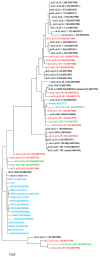New Insights from Elucidating the Role of LMP1 in Nasopharyngeal Carcinoma
- PMID: 29561768
- PMCID: PMC5923341
- DOI: 10.3390/cancers10040086
New Insights from Elucidating the Role of LMP1 in Nasopharyngeal Carcinoma
Abstract
Latent membrane protein 1 (LMP1) is an Epstein-Barr virus (EBV) oncogenic protein that has no intrinsic enzymatic activity or sequence homology to cellular or viral proteins. The oncogenic potential of LMP1 has been ascribed to pleiotropic signaling properties initiated through protein-protein interactions in cytosolic membrane compartments, but the effects of LMP1 extend to nuclear and extracellular processes. Although LMP1 is one of the latent genes required for EBV-immortalization of B cells, the biology of LMP1 in the pathogenesis of the epithelial cancer nasopharyngeal carcinoma (NPC) is more complex. NPC is prevalent in specific regions of the world with high incidence in southeast China. The epidemiology and time interval from seroconversion to NPC onset in adults would suggest the involvement of multiple risk factors that complement the establishment of a latent and persistent EBV infection. The contribution of LMP1 to EBV pathogenesis in polarized epithelia has only recently begun to be elucidated. Furthermore, the LMP1 gene has emerged as one of the most divergent sequences in the EBV genome. This review will discuss the significance of recent advances in NPC research from elucidating LMP1 function in epithelial cells and lessons that could be learned from mining LMP1 sequence diversity.
Keywords: Epstein-Barr virus; LMP1; epithelial infection; nasopharyngeal carcinoma.
Conflict of interest statement
There are no conflicts of interest to declare.
Figures



Similar articles
-
Latent Membrane Protein 1 Is a Novel Determinant of Epstein-Barr Virus Genome Persistence and Reactivation.mSphere. 2017 Nov 8;2(6):e00453-17. doi: 10.1128/mSphereDirect.00453-17. eCollection 2017 Nov-Dec. mSphere. 2017. PMID: 29134204 Free PMC article.
-
Regulation of DNA Damage Signaling and Cell Death Responses by Epstein-Barr Virus Latent Membrane Protein 1 (LMP1) and LMP2A in Nasopharyngeal Carcinoma Cells.J Virol. 2015 Aug;89(15):7612-24. doi: 10.1128/JVI.00958-15. Epub 2015 May 13. J Virol. 2015. PMID: 25972552 Free PMC article.
-
Modified Anoikis Assay That Functionally Segregates Epstein-Barr Virus LMP1 Strains into Two Groups.J Virol. 2018 Aug 29;92(18):e00557-18. doi: 10.1128/JVI.00557-18. Print 2018 Sep 15. J Virol. 2018. PMID: 29950426 Free PMC article.
-
Pathogenic role of Epstein-Barr virus latent membrane protein-1 in the development of nasopharyngeal carcinoma.Cancer Lett. 2013 Aug 28;337(1):1-7. doi: 10.1016/j.canlet.2013.05.018. Epub 2013 May 17. Cancer Lett. 2013. PMID: 23689138 Review.
-
EBV Infection and Glucose Metabolism in Nasopharyngeal Carcinoma.Adv Exp Med Biol. 2017;1018:75-90. doi: 10.1007/978-981-10-5765-6_6. Adv Exp Med Biol. 2017. PMID: 29052133 Review.
Cited by
-
Epstein-Barr Virus Mediated Signaling in Nasopharyngeal Carcinoma Carcinogenesis.Cancers (Basel). 2020 Aug 28;12(9):2441. doi: 10.3390/cancers12092441. Cancers (Basel). 2020. PMID: 32872147 Free PMC article. Review.
-
Intra-host changes in Kaposi sarcoma-associated herpesvirus genomes in Ugandan adults with Kaposi sarcoma.PLoS Pathog. 2021 Jan 19;17(1):e1008594. doi: 10.1371/journal.ppat.1008594. eCollection 2021 Jan. PLoS Pathog. 2021. PMID: 33465147 Free PMC article.
-
Conformational change of adenine nucleotide translocase-1 mediates cisplatin resistance induced by EBV-LMP1.EMBO Mol Med. 2021 Dec 7;13(12):e14072. doi: 10.15252/emmm.202114072. Epub 2021 Nov 9. EMBO Mol Med. 2021. PMID: 34755470 Free PMC article.
-
The association between lncRNA H19 and EZH2 expression in patients with EBV-positive laryngeal carcinoma.Acta Otorhinolaryngol Ital. 2021 Dec;41(6):537-543. doi: 10.14639/0392-100X-N1527. Epub 2021 Nov 26. Acta Otorhinolaryngol Ital. 2021. PMID: 34825669 Free PMC article.
-
The roles of ribosomal proteins in nasopharyngeal cancer: culprits, sentinels or both.Biomark Res. 2021 Jun 30;9(1):51. doi: 10.1186/s40364-021-00311-x. Biomark Res. 2021. PMID: 34193301 Free PMC article. Review.
References
Publication types
Grants and funding
LinkOut - more resources
Full Text Sources
Other Literature Sources
Research Materials

